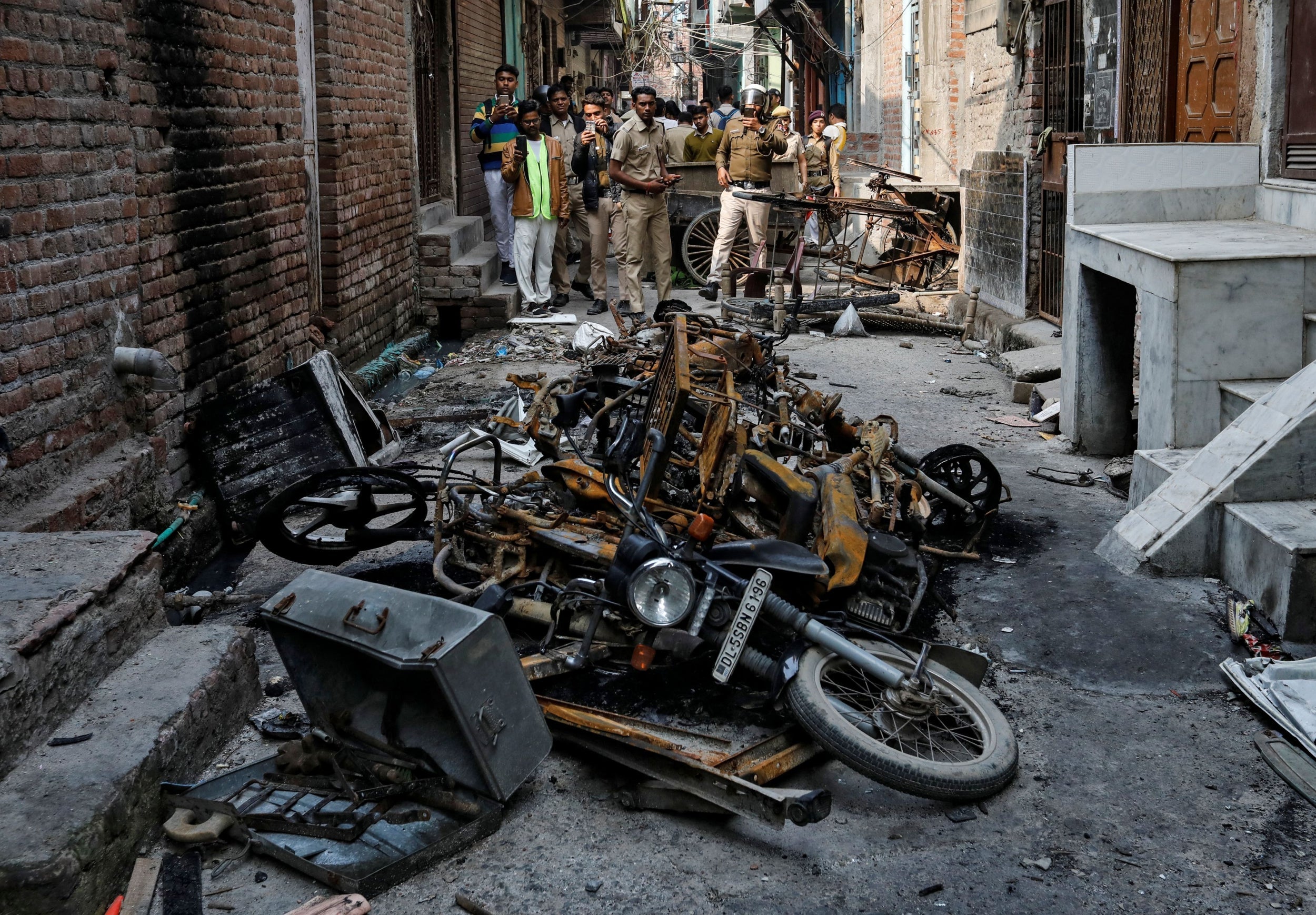Delhi riots: Violence that killed 53 in Indian capital ‘was anti-Muslim pogrom’, says top expert
‘Police were displaying clear signs of partisanship ... looking on while the mob was going after civilians, going into homes, burning property, killing people,’ Adam Withnall is told


The religious violence in Delhi that overshadowed Donald Trump’s visit to India last month “qualifies as a pogrom” against Muslims and should be described as such, according to a leading academic and one of the country’s top lawyers.
The fallout from the three days of bloodshed in Delhi, which began two weeks ago on Sunday and ended in the deaths of at least 53 people, is still being fiercely contested, with police facing intense criticism for their perceived failure to step in and quash the unrest sooner.
There are mounting calls for the arrest of key members of the country’s ruling BJP party, accused of inciting Hindu mobs to mobilise in the capital and target mosques, Muslims and Muslim-owned homes and businesses in a trail of destruction.
But at the same time, the government of Narendra Modi has almost completely refused to comment on the violence, denying opposition demands for a debate in parliament, dismissing expressions of concern from the international community and punishing media outlets whose coverage of the riots it finds disagreeable.
On Friday the Delhi Minorities Commission released a report, based on its assessments of damage on the ground in the riot-affected areas of the capital, stating that Muslims suffered the worst of the violence, but stopping short of criticising the police.
“It is our assessment that the violence in northeast district of Delhi was one-sided and well planned, in which maximum damage was inflicted on Muslim houses and shops with local support,” the report read.
Ashutosh Varshney, director of the Centre for Contemporary South Asia at Brown University, said the violence may have started out as riots between those for and against the Modi administration’s new citizenship laws – which critics say discriminate against Muslims – but that “within 24 hours it became clear that a riot is beginning to look like a pogrom”.
A pogrom, Mr Varshney told The Independent, is defined as when a state or its forces stands aside while a minority is coming under attack. “The key difference [with riots] is that the police were displaying clear signs of partisanship ... looking on while the mob was going after civilians, going into homes, burning property, killing people.”
Mr Varshney is the author of Ethnic Conflict and Civic Life: Hindus and Muslims in India, a book on religious riots in India, and this week gave evidence about the events in Delhi at a Washington hearing of the US Commission on International Religious Freedom (USCIRF).
He said an analysis of the list of victims from the violence shows around two-thirds were Muslims, despite them being a minority community in most of the riot-affected areas of northeastern Delhi.
“That itself, to any scholar of riots, would suggest that it began as a riot and then became a pogrom, where Muslims civilians were targeted disproportionately,” he said.
An initial police report into the violence claims officers were not available in sufficient numbers to quash the riots initially, and senior officers have given interviews saying they were then waiting for “directions from top (government)” to act. The city’s police commissioner, Amulya Patnaik, has been replaced – made a scapegoat amid the public outcry, fellow officers say.
Meanwhile, footage has circulated of police actively joining Hindus in acts of violence against Muslims, from throwing stones to beating men lying badly injured in the streets, forcing them to repeat Hindu nationalist slogans. The broadcast of some of these videos by the BBC prompted UK parliamentarians to call an urgent question in the House of Commons, demanding Boris Johnson’s government raise concerns with India through diplomatic channels.
Prashant Bhushan, a prominent activist and one of India’s most famous public litigation lawyers, said the courts should have stepped in and called upon the army to restore law and order, amid the “considerable evidence suggesting the police not only did not stop [the mob] but even participated in the violence”.
He told The Independent: “The government was totally complicit, there is no doubt, or the police would not have behaved in this manner. It was a state-sponsored, almost one-sided attack. It was a pogrom.”
Mr Bhushan said the Supreme Court, which has received scores of petitions relating to the riots, should establish its own special investigative team to look into the allegations against the police.
“The whole investigation of this matter can’t be left to the police, which was clearly partisan and is acting as the accused in these cases,” he said. “The same officers who were involved in the violence are supposed to be investigating their own role as well. It’s ridiculous.”
The terminology used to describe the events in Delhi two weeks ago makes a difference, Mr Varshney said, because “when riots become pogroms, then the role of the state is really what generates alarm and gets discussed – that’s why the category matters. It is not the job of the state to side with any community, let alone the majority community. That is a fundamental principle of democracy.”
For India’s broadcast media, decisions about how to frame coverage of religious riots are not just a matter of editorial integrity – it can find them falling on the wrong side of the law.
That is because they are subject to regulations, under the Programme Code of the Cable TV Network Act 1995, which make it illegal for TV channels to show any programme that could “promote communal attitudes” or “is likely to encourage or incite violence or contains anything against maintenance of law and order or which promotes anti-national attitudes”.
The law is open to broad interpretation, and leads major news channels to self-censor. At the height of the Delhi riots, New Delhi Television (NDTV) refused to show most footage of the violence and described the clashes in cryptic terms, such as between “members of the majority/minority community”.
For 48 hours from Friday evening, two southern Indian channels were suspended from broadcasting over their coverage of the Delhi riots. Offending segments, according to a government notice, included an anchor saying that “it seems the vandals and police are hand in glove”, and suggesting “the situation is getting out of hand” when the home ministry had described it otherwise.
In a statement, the editor in chief of one of the channels – MediaOne TV – called the broadcasting ban “a blatant attack against free and fair reporting” and “[an] unprecedented and undemocratic action”.
While admonishing its own media, the Indian government has strongly resisted a growing international alarm at the events in Delhi, accusing critics of interfering in India’s internal affairs or having their own agenda.
On Friday, with figures as disparate as US Democrats and the supreme leader of Iran criticising what the latter called “the massacre of Muslims” in Delhi, Modi’s foreign minister S Jaishankar was asked if India was losing friends around the world in the wake of the riots. He replied: “Maybe we are getting to know who our friends really are.”
Join our commenting forum
Join thought-provoking conversations, follow other Independent readers and see their replies
Comments